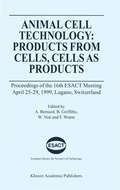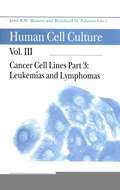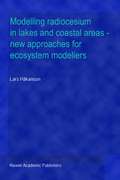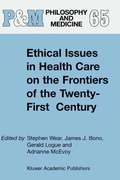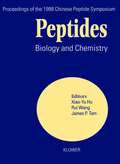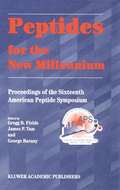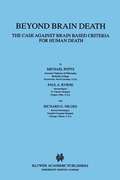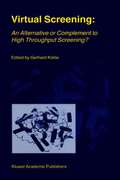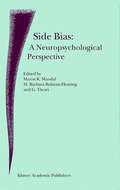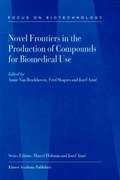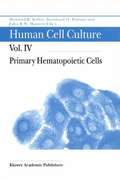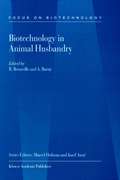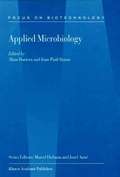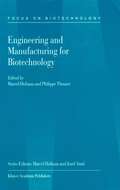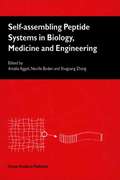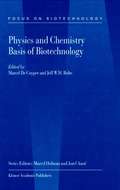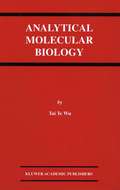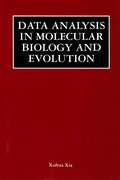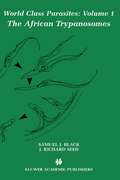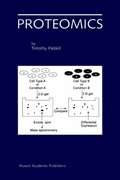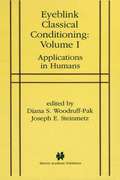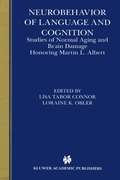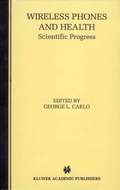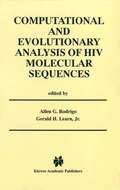- Table View
- List View
Animal Cell Technology: Proceedings of the 16th ESACT Meeting April 25–29, 1999, Lugano, Switzerland
by Wolfgang Noé Florian Wurm Alain Bernard Bryan GriffithsProceedings of the 16th ESACT Meeting, April 25-29, 1999, Lugano, Switzerland
Cancer Cell Lines: Part 3: Leukemias and Lymphomas (Human Cell Culture #3)
by John Masters Bernhard Ø. PalssonThis book describes all human leukemia-lymphoma cell lines that have been established and that grow continuously under standardised in vitro conditions. These lines are derived from cells belonging to all the major hematopoietic cell lineages, i.e. B- and T-lymphocytes, natural killer cells, granulocytic cells and megakaryocytic cells. The clinical data, the culture conditions and the major phenotypic features of the cell lines are described with citations. This book is the first book describing human leukemia-lymphoma cell lines and will be of interest to scientists involved in the areas of hematology, oncology, immunology, molecular biology and cytogenetics. Cancer Cell Lines, Volumes 1-3: These 3 volumes provide a comprehensive text on the culture of established cell lines from every type of human cancer. The volumes provide a basic manual and reference resource for every cancer research scientist using human cancer cells.
Modelling radiocesium in lakes and coastal areas — new approaches for ecosystem modellers: A textbook with Internet support
by Lars HåkansonDuring the last 10 years, there has been a `revolution' in ecosystem modelling. The generality and predictive power of our models have increased in a way that was inconceivable 10 years ago. This book describes a new generation of practically useful models that predict as well as one can measure - if one measures well. And yet, they are driven by readily available driving variables and have a general structure that applies to most types of pollutants in aquatic systems. The major reason for this development is, in fact, the Chernobyl accident. Large quantities of radiocesium were released in April/May 1986 as a pulse. To follow the pulse of radiocesium through ecosystem pathways has meant that important fluxes and mechanisms, i.e., ecosystem structures, have been revealed. It is important to stress that many of these new structures and equations are valid not just for radiocesium, but for most types of contaminants, e.g. for metals, nutrients and organics. This means that the models, methods (of building and testing models) and equations described in this book for lakes and coastal areas should be of great interest also to other ecosystem modellers. This book will be of considerable interest to: students in radioecology, geosciences and biology; environmental engineers; consultants; administrators and scientists interested in the spread, biouptake and ecosystem effects of chemical pollutants in aquatic ecosystems.
Ethical Issues in Health Care on the Frontiers of the Twenty-First Century (Philosophy and Medicine #65)
by Stephen Wearof UB’s medical school, that UB developed its School of Arts and Sciences, and thus, assumed its place among the other institutions of higher education. Had Fillmore lived throughout UB’s first seventy years, he would probably have been elated by the success of his university, and he should have been satisfied and pleased that UB remained intrinsically bonded to its community while at the same time engrafting the values and standards important to higher education’s mission in the region. UB and its medical school have undergone many challenging transitions since 1846. Included among them were: (1) the completion of an academic campus in the far northeast comer of the City of Buffalo while leaving its medical, dental and law schools firmly situated in the core of downtown Buffalo; (2) the eventual relocation, after the second world war, of the law school to the newer campus in Amherst, and the medical and dental school to the original academic campus: and (3) the merger with the State University of New York System in 1962. Despite these significant transitions, any one of which could have changed the intrinsic integrity of UB and disrupted the bonding between community and university, that did not happen. To this day, the ties between community and academe persist. Fillmore and White should celebrate their success and important contribution to Buffalo and Western New York.
Peptides: Biology and Chemistry (Chinese Peptide Symposia)
by James P. Tam Xiao-Yu Xiao-Yu Hu Rui Rui WangThe Fifth Chinese Peptide Symposium, hosted by Lanzhou University, was held at Lanzhou, China July 14-17, 1998, with 156 participants, including 30 scientists from abroad, representing nine countries. The four-day conference was both intense and spiritually rewarding. Our goal for CPS-98 was to provide a forum for the exchange of knowledge, cooperation and friendship between the international and Chinese scientific communities, and we believe this goal was met. The symposium consisted of 8 sessions with 42 oral and 90 poster presentations, including synthetic methods, molecular diversity and peptide libraries, structure and conformation of peptides and proteins, bioactive peptides, peptide immunology, De Novo design and synthesis of proteins and peptides, ligand-receptor interactions, the chemistry-biology-interface and challenging problems in peptides. The enthusiastic cooperation and excellent contributions were gratifying and the active response of the invited speakers contributed to the success of the symposium. The presentations were of excellent caliber and represented the most current and significant aspects of peptide science. Dr. Kit Lam of the University of Arizona and Dr. Yun-Hua Ye of Peking University were the recipients of “The Cathay Award” sponsored by the H. H. Liu Education Foundation, offered for their seminal contribution in peptide science and the Chinese Peptide Symposium. Four outstanding young scientists were selected by the organizing committee to receive awards sponsored by Haikou Nanhai Pharmaceutical Industry Co. Ltd. (Zhong He Group).
Peptides for the New Millennium: Proceedings of the 16th American Peptide Symposium June 26–July 1, 1999, Minneapolis, Minnesota, U.S.A. (American Peptide Symposia #6)
by Gregg B. Fields James P. Tam George Barany“Have you tried peptides? Small proteins, the best in the land! Won’t you try peptides? Keep all your body processes in hand! For labor and lactation oxytocin you must buy! Enkephalin always gives a good runner’s high! So won’t you try peptides? Small proteins, the best in the land!” The above words [1], penned by Gary Gisselman to open Peptide Ångst: La Triviata, the opera which made its world premiere on July 1, 1999, also serve as a fitting charge to the th 16 American Peptide Symposium. This latest edition of a premier biennial series was held under the auspices of the American Peptide Society, June 26–July 1, 1999, at the Minneapolis Convention Center, Minneapolis,Minnesota, with the undersigned serving as Co-Chairs. The fortunate coincidence of the calendar allowed us to set as the theme “Peptides for the New Millennium”, and in our judgment, the approximately 1200 participants [2] who converged in the Twin Cities from academic and industrial institutions in 36 countries were treated to an exciting and stimulating conference that left most everyone with an enthusiastic vision for the future of our field. The present Proceedings volume should serve as a handy reference source and succinct snapshot of peptide science at essentially its century mark – the clock having started with the initial contributions of Emil Fischer and Th. Curtius.
Beyond Brain Death: The Case Against Brain Based Criteria for Human Death (Philosophy and Medicine #66)
by P. A. Byrne R. G. Nilges M. PottsBeyond Brain Death offers a provocative challenge to one of the most widely accepted conclusions of contemporary bioethics: the position that brain death marks the death of the human person. Eleven chapters by physicians, philosophers, and theologians present the case against brain-based criteria for human death. Each author believes that this position calls into question the moral acceptability of the transplantation of unpaired vital organs from brain-dead patients who have continuing function of the circulatory system. One strength of the book is its international approach to the question: contributors are from the United States, the United Kingdom, Liechtenstein, and Japan. This book will appeal to a wide audience, including physicians and other health care professionals, philosophers, theologians, medical sociologists, and social workers.
Virtual Screening: Proceedings of the Workshop ‘New Approaches in Drug Design and Discovery’, special topic ‘Virtual Screening’, Schloß Rauischholzhausen, Germany, March 15–18, 1999
by Gerhard KlebeIn the next couple of years the human genome will be fully sequenced. This will provide us with the sequence and overall function of all human genes as well as the complete genome for many micro-organisms. Subsequently it is hoped, by means of powerful bioinformatic tools, to determine the gene variants that contribute to various multifactorial diseases and genes that exist in certain infectious agents but not humans. As a consequence, this will allow us to define the most appropriate levels for drug intervention. It can be expected that the number of potential drug targets will increase, possibly by a factor of 10 or more. Nevertheless, sequencing the human genome or, for that matter, the genome of other species will only be the starting point for the understanding of their biological function. Structural genomics is a likely follow-up, combined with new techniques to validate the therapeutic relevance of such newly discovered targets. Accordingly, it can be expected that in the near future we will witness a substantial increase in novel putative targets for drugs. To address these new targets effectively, we require new approaches and innovative tools. At present, two alternative, yet complementary, techniques are employed: experimental high-throughput screening (HTS) of large compound libraries, increasingly provided by combinatorial chemistry, and computational methods for virtual screening and de novo design. As kind of status report on the maturity of virtual screening as a technique in drug design, the first workshop on new approaches in drug design and discovery was held in March 1999, at Schloß Rauischholzhausen, near Marburg in Germany. More than 80 scientists gathered and discussed their experience with the different techniques. The speakers were invited to summarize their contributions together with their impressions on the present applicability of their approach. Several of the speakers followed this request which is summarized in this publication.
Side Bias: A Neuropsychological Perspective
by Manas K. Mandal`Rather than being an esoteric aspect of brain function, lateralization is a fundamental characteristic of the vertebrate brain essential to a broad range of neural and behavioral processes.' Professor Lesley J. Rogers, Chapter 1 of Side Bias: A Neuropsychological Perspective. This volume contains 14 chapters from a veritable `United Nations' of experts in the field of lateralization of function. They write comprehensive reviews, present data, and pose new questions concerning the evolutionary origins and development of side bias, methodological concerns with the way we measure handedness and footedness, and some more unusual aspects of human beings' lateralized behavior, such as asymmetrical cradling and pseudoneglect. The book will be essential reading for students of behavioral neuroscience and neuropsychology interested in lateralization of function as well as for established researchers in the field.
Novel Frontiers in the Production of Compounds for Biomedical Use (Focus on Biotechnology #1)
by Fred Shapiro Jozef Anné A. Van BroekhovenThe present book entitled “Novel Frontiers in the Production of Compounds for Biomedical Uses” can perhaps be placed in its best perspective by the Shakespearean character in The Tempest who exclaimed" What’s past is prologue”. Indeed, this compilation of some of the outstanding presentations in the field of biomedicine made at th the 9 European Congress on Biotechnology (Brussels, Belgium, July 11-15, 1999) not only reflects the achievements of the recent past, but provides a privileged glimpse of the biotechnology that is emerging in the first decade of the new Millennium. It is becoming increasingly apparent that biotechnology is offering biomedicine novel approaches and solutions to develop a sorely needed new generation of biopharmaceuticals. This is all the more necessary because in recent years, new diseases have emerged with extraordinary lethality in all corners of the globe, while age-related chronic illnesses have filled the gap wherever biomedicine has made successful inroads. The rise of antibiotic resistance also poses major threats to public health. Thus, as disease patterns evolve, the rational development of new drugs is becoming urgent, not only for the clinical outcome of patients, but also in optimising the allocation of scarce health care resources through the use of cost-effective productions methods. It is in response to all these challenges that biotechnology offers new strategies that go beyond the more traditional approaches. By the mid-1990’s, the number of recombinant products approved annually for therapeutic use reached double digits. With the advent of the genomics revolution.
Human Cell Culture: Primary Hematopoietic Cells (Human Cell Culture #4)
by Bernhard Ø. Palsson F. Koller John MastersThe daily production of hundreds of billions of blood cells through the process of hematopoiesis is a remarkable feat of human physiology. Transport of oxygen to tissues, blood clotting, antibody- and cellular-mediated immunity, bone remodeling, and a host of other functions in the body are dependent on a properly functioning hematopoietic system. As a consequence, many pathological conditions are attributable to blood cell abnormalities, and a fair number of these are now clinically treatable as a direct result of hematopoietic research. Proliferation of hematopoietic stem cells, and their differentiation into the many different lineages of functional mature cells, is highly regulated and responsive to many environmental and physiological challenges. Our relatively advanced understanding of this stem cell system provides potentially important insights into the regulation of development in other tissues, many of which are now being acknowledged as stem ce- based, perhaps even into adulthood. The recent public and scientific fanfare following announcement of human embryonic stem cell studies suggests that stem cell research will continue to be a relevant and exciting topic.
Biotechnology in Animal Husbandry (Focus on Biotechnology #5)
by R. Renaville A. BurnyAnimal biotechnology is a broad umbrella encompassing the polarities of fundamental and applied research including molecular modelling, molecular and quantitative genetics, gene manipulation, development of diagnostics and vaccines and manipulation of tissue or digestion metabolism by growth promoters. Although animal biotechnology in the broadest sense is not new, what is new is the level of complexity and precision involved in scientists' current ability to manipulate living organisms. This new book sets out to show that the important ideas in animal biotechnology are exciting and relevant to everyday experience. It represents an important update of the literature for research workers, lecturers, and advisers in animal science, but is also a core text for advanced undergraduate courses in animal science and biotechnology. It will be an essential acquisition for librarians in agriculture and veterinary science.
Applied Microbiology (Focus on Biotechnology #2)
by A. Durieux J. P. SimonThis book illustrates the major trends in applied microbiology research with immediate or potential industrial applications. The papers proposed reflect the diversity of the application fields. New microbial developments have been done as well in the food and health sectors than in the environmental technology or in the fine chemical production. All the microbial genera are involved : yeast, fungi and bacteria. The development of biotechnology in parallel with the industrial microbiology has enabled the application of microbial diversity to our socio-economical world. The remarkable properties of microbes, inherent in their genetic and enzymatic material, allow a wide range of applications that can improve our every day life. Recent studies for elucidating the molecular basis of the physiological processes in micro-organisms are essential to improve and to control the metabolic pathways to overproduce metabolites or enzymes of industrial interest. The genetic engineering is of course one of the disciplines offering new horizons for the « fantastic microbial factory » . Studies of the culture parameter incidence on the physiology and the morphology are essential to control the response of the micro-organisms before its successful exploitation at the industrial scale. For this purpose, fundamental viewpoints are necessary. Development of novel approaches to characterise micro-organisms would also facilitate the understanding of the inherent metabolic diversity of the microbial world, in terms of adaptation to a wide range of biotopes and establishment of microbial consortia.
Engineering and Manufacturing for Biotechnology (Focus on Biotechnology #4)
by M. Hofman P. ThonartEarly integration is the key to success in industrial biotechnology. This is as true when a selected wild-type organism is put to work as when an organism is engineered for a purpose. The present volume Engineering and Manufacturing for Biotechnology took advantage of the 9th European Congress on Biotechnology (Brussels, Belgium, July 11-15, 1999): in the topics handled and in the expertise of the contributors, the engineering science symposia of this congress offered just what was needed to cover the important topic of integration of process engineering and biological research. The editors have solicited a number of outstanding contributions to illustrate the intimate interaction between productive organisms and the numerous processing steps running from the initial inoculation to the packaged product. Upstream processing of the feed streams, selection of medium components, product harvesting, downstream processing, and product conditioning are just a few major steps. Each step imposes a number of important choices. Every choice is to be balanced against time to market, profitability, safety, and ecology.
Self-Assembling Peptide Systems in Biology, Medicine and Engineering
by A. Aggeli N. Boden Zhang ShuguangOne ofthe major drivers in biological research is the establishment ofstructures and functions of the 50,000 or so proteins in our bodies. Each has a characteristic- dimensional structure, highly "ordered" yet "disordered"! This structure is essential for a protein's function and, significantly, it must be sustained in the competitive and complex environment of the living cell. It is now being recognised that when a cell loses control, proteins can se- assemble into more complex supermolecular structures such as the amyloid fibres and plaques associated with the pathogenesis of prion (CJD) or age-related (Alzheimer's) diseases. This is a pointer to the wider significance of the self-assembling properties of polypeptides. It has been long known that, in silk, polypeptides are assembled into- sheet structures which impart on the material its highly exploitable properties of flexibility combined with high tensile strength. But only now emerging is the recognition that peptides can Self-assemble into a wide variety of non-protein-like structures, including fibrils, fibres, tubules, sheets and monolayers. These are exciting observations and, more so, the potential for materials and medical exploitations is so wide ranging that over 80 scientists from Europe, USA, Japan and Israel. met 1-6 July 1999 in Crete, to discuss the wide-ranging implications of these novel developments. There was a spirit of excitement about the workshop indicative of an important new endeavor. The emerging perception is that of a new class of materials set to become commercially viable early in the 21st century.
Physics and Chemistry Basis of Biotechnology (Focus on Biotechnology #7)
by Jeff W. M. Bulte M. De CuyperAt the end of the 20th century, a tremendous progress was made in biotechnology in its widest sense. This progress was largely possible as a result of joint efforts of top academic researchers in both pure fundamental sciences and applied research. The surplus value of such interdisciplinary approaches was clearly highlighted during the 9th European Congress on Biotechnology that was held in Brussels, Belgium (11-15 July, 1999). The present volume in the ‘Focus on Biotechnology’ series, entiteld ‘Physics and Chemistry Basis for Biotechnology’ contains selected presentations from this meeting, A collection of experts has made serious efforts to present some of the latest developments in various scientific fields and to unveil prospective evolutions on the threshold of the new millenium. In all contributions the emphasis is on emerging new areas of research in which physicochemical principles form the foundation. In reading the different chapters, it appears that more than ever significant advances in biotechnology very often depend on breakthroughs in the biotechnology itself (e.g.
Analytical Molecular Biology
by Tai Te WuAnalytical Molecular Biology illustrates the importance of simple analytical methods applied to some basic molecular biology problems, with an emphasis on the importance of biological problems, rather than the complexity of mathematics. First, the book examines crucial experimental data for a specific problem. Mathematical models will then be constructed with explicit inclusion of biological facts. From such models, predictions can be deduced and then suggest further experimental studies. A few important molecular biology problems will be discussed in the order of the complexity of the mathematical models. Based on such illustrations, the readers can then develop their own analytical methods to study their own problems. This book is for anyone who knows they need to learn how to apply mathematical models to biology, but doesn't necessarily want to, from practicing researchers looking to acquire more analytical tools to advanced students seeking a clear, explanatory text.
Data Analysis in Molecular Biology and Evolution
by Xuhua XiaData Analysis in Molecular Biology and Evolution introduces biologists to DAMBE, a proprietary, user-friendly computer program for molecular data analysis. The unique combination of this book and software will allow biologists not only to understand the rationale behind a variety of computational tools in molecular biology and evolution, but also to gain instant access to these tools for use in their laboratories. Data Analysis in Molecular Biology and Evolution serves as an excellent resource for advanced level undergraduates or graduates as well as for professionals working in the field.
The African Trypanosomes (World Class Parasites #1)
by Samuel J. Black J. Richard SeedAfrican trypanosomes are tsetse-transmitted protozoa that inhabit the extracellular compartment of host blood. They cause fatal sleeping sickness in people, and Nagana, a wasting and generally fatal disease, in cattle. While trypanosomes are most common to Africa (about 30% of Africa's cattle graze on the fringe of the tsetse habitat), some species have spread beyond its boarders to Asia, the Middle East and South America. The African Trypanosomes, volume one of World Class Parasites, is written for researchers, students and scholars who enjoy reading research that has a major impact on human health, or agricultural productivity, and against which we have no satisfactory defense. It is intended to supplement more formal texts that cover taxonomy, life cycles, morphology, vector distribution, symptoms and treatment. It integrates vector, pathogen and host biology and celebrates the diversity of approach that comprises modern parasitological research.
Proteomics
by Timothy PalzkillProteomics is an introduction to the exciting new field of proteomics, an interdisciplinary science that includes biology, bioinformatics, and protein chemistry. The purpose of this book is to provide the active researcher with an overview of the types of questions being addressed in proteomics studies and the technologies used to address those questions. Key subjects covered in this book include: an assessment of the limitations of this approach and outlines new developments in mass spectrometry that will advance future research high-throughput recombinant DNA cloning methods used to systematically clone all of the open reading frames of an organism into plasmid vectors for large scale protein expression and functional studies such as protein-protein interactions with the two-hybrid system protein structure an overview of large-scale experimental attempts to determine the three-dimensional structures of representative sets of proteins computational approaches to determining the three-dimensional structure of proteins. Proteomics provides a starting point for researchers who would like a theoretical understanding of the new technologies in the field, and obtain a solid grasp of the fundamentals before integrating new tools into their experiments. Written with attention to detail, but without being overwhelmingly technical, Proteomics is a user-friendly guide needed by most biologists today.
Eyeblink Classical Conditioning Volume 1: Applications in Humans
by Diana Woodruff-PakThe model system of eyeblink classical conditioning in humans has enormous potential for the understanding and application of fundamental principles of learning. This collection makes classical conditioning accessible to teachers and researchers in a number of ways. The first aim is to present the latest developments in theory building. Second, as background for the current directions, Eyeblink Classical Conditioning, Volume I presents an overview of a large body of previously published research on eyeblink classical conditioning. Last, the authors describe eyeblink classical conditioning techniques. Each chapter includes a highlighted methods section so that interested readers can replicate techniques for teaching and research.
Eyeblink Classical Conditioning Volume 2: Animal Models
by Diana S. Woodruff-PakClassical conditioning of the nictitating membrane (NM) eyeblink response in rabbits is a useful model system for the study of the neurobiology of learning and memory. This paradigm that is so well described on a biological level has also been applied to studies of normal development over the life span and to instances of abnormal developmental phenomena. Eyeblink conditioning has been studied from molecular and neural network perspectives, and the paradigm is of demonstrated utility in elucidating mechanisms in physiology and pharmacology. This model system provides a behavioral paradigm in animals that has a close analog in human behavior. Perspectives of recent developments in human eyeblink classical conditioning research are presented in the companion volume to this book, Eyeblink Classical Conditioning: Applications in Humans.
Neurobehavior of Language and Cognition: Studies of Normal Aging and Brain Damage
by Loraine K. Obler Lisa TaborConnorThis volume has been composed as an appreciation of Martin L. Albert in the year of his 60th birthday. At least one contributor to each paper in this volume has been touched by Marty in some way; lie has mentored some, been a fellow student with some, and been a colleague to most. These contributors, as well as many others, view Marty as a gifted scientist and a wonderful human being. The breadth of his interests and intellectual pursuits is truly impressive; this breadth is reflected, only in part. by the diversity of the papers in this volume. His interests have ranged from psychopharmacology to cross-cultural understanding of dementia, through the aphasias, to the history of the fields that touch on behavioral neurology, especially neurology per se, cognitive psychology, speech-language pathology, and linguistics. Throughout his scholarly work, Martha Taylor Sarno notes, Marty never loses the human perspective, e. g. , the “powerfully disabling effect on the individual person” with aphasia or other neurological disorder. For those readers who only how a portion of his work, we thought that we should describe him here. Many of the people whom Marty has influenced have been able to contribute to this volume. We have invited some others who were unable to contribute to express their appreciation for him, as well.
Wireless Phones and Health: Scientific Progress (Wireless Phones And Health Ser.)
by George L. CarloComputational and Evolutionary Analysis of HIV Molecular Sequences
by Allen G. Rodrigo Gerald H. LearnComputational and Evolutionary Analysis of HIV Molecular Sequences is for all researchers interested in HIV research, even those who only have a nodding acquaintance with computational biology (or those who are familiar with some, but not all, aspects of the field). HIV research is unusual in that it brings together scientists from a wide range of disciplines: clinicians, pathologists, immunologists, epidemiologists, virologists, computational biologists, structural biologists, evolutionary biologists, statisticians and mathematicians. This book seeks to bridge the gap between these groups, in both subject matter and terminology. Focused largely on HIV genetic variation, Computational and Evolutionary Analysis of HIV Molecular Sequences covers such issues as sampling and processing sequences, population genetics, phylogenetics and drug targets.
